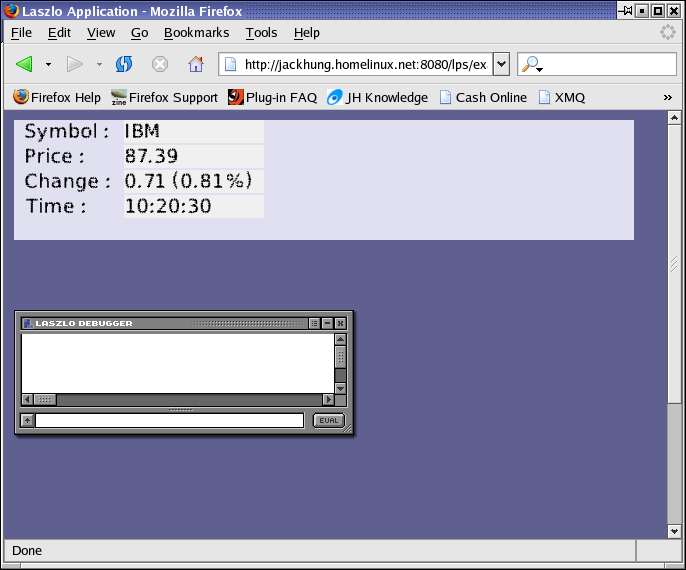First here is the simple client application. Here, I just use a local dataset
sampledataset.lzx to try out the UI.

What I've done here is to wrap the dataset within a connectiondatasource and
create a connection specifying an agent. Note that the actuall url
of the agent is not important at this point. What we are doing here is to make sure we can connect to
the LPS with a persistant connection.
<connection authenticator="anonymous" group="client">
<agent url="http://localhost:8080/lps/examples/quoteServer/somepath"/>
<method event="onconnect">
Debug.write("Connected with auth param: " + this.getAuthParam());
</method>
<method event="onerror" args="error">
Debug.write("Connection Error" + error);
</method>
</connection>
<script>
canvas.connection.setAuthParam('usr=guest');
canvas.connection.connect();
</script>
<connectiondatasource name="agentDatasource">
<dataset name="sampleQuote"/>
</connectiondatasource>
You should see the connection message as displayed here:

-
Version 3
(
view source)
Next we need to send our quote request to the server, note the request is in XML (eg.
<getquote user="guest" symbol="IBM"/>):
I also set up a<button x="10" y="140" >Send XML to Server <method event="onclick"> <![CDATA[ var to = "http://localhost:8080/lps/examples/quoteServer/getquote.jsp"; var xml = '<getquote user="guest" symbol="IBM"/>'; agentDatasource.sendAgentXML(to, xml); ]]> Debug.write("Sent: " + xml); </method> </button>datapointerto display the responsedsetofsendAgentXML:<datapointer xpath="agentDatasource:sendXMLDset:/*[1]"> <method event="ondata" args="response"> Debug.write("Response: " + response); </method> <method event="onerror" args="err"> Debug.write("Error sending XML: " + err.errorstring); </method> </datapointer> - Simulating the response by QuoteServer
Now I need some way to answer to the quote request. Note above that I have changed the
agent path to point to quoteServer/getquote.jsp.
The actual response by the server does not seem to matter.
For now, I just use a simple JSP (returning an XML message with the XML reqest received)
to keep LPS happy.
<%
String xml = request.getParameter("xml");
if (xml == null || xml.length() == 0) {
xml = "<nothing/>";
}
%>
<getrequest_response time="<%=new Date()%>">
<xml-msg>
<%=xml%>
</xml-msg>
</getrequest_response>
LPS will proxy the request to the back-end server (
.../quoteServer/getquote.jsp?xml=<getquote user="guest" symbol="IBM"/>).
Click on the above link to see a sample response. When you click on the button to send the request, you should see the response from LPS. (I wonder if it is possible to get access to the response from the back-end server, will look into that later)

Now we have a persistant connection to LPS which acts as an agent between our client application
and the back-end server, and we have faked an request to the faked back-end server.
Next we'll emulate the QuoteServer pushing data to the application using the form below:

Also note the response from LPS to the back-end server when you submit the form, this is helpful when you are actually implementing your server in a servlet.
When you are implementing your server, you might need to detect the client disconnecting without
informing the server. You can use the agentlist to determine if a client is still connected.
The following simulate the communication format for the agentlist protocol:
<lps>
<status>200</status>
<message>ok</message>
<body>
<list>
<user name="guest"/>
</list>
</body>
</lps>